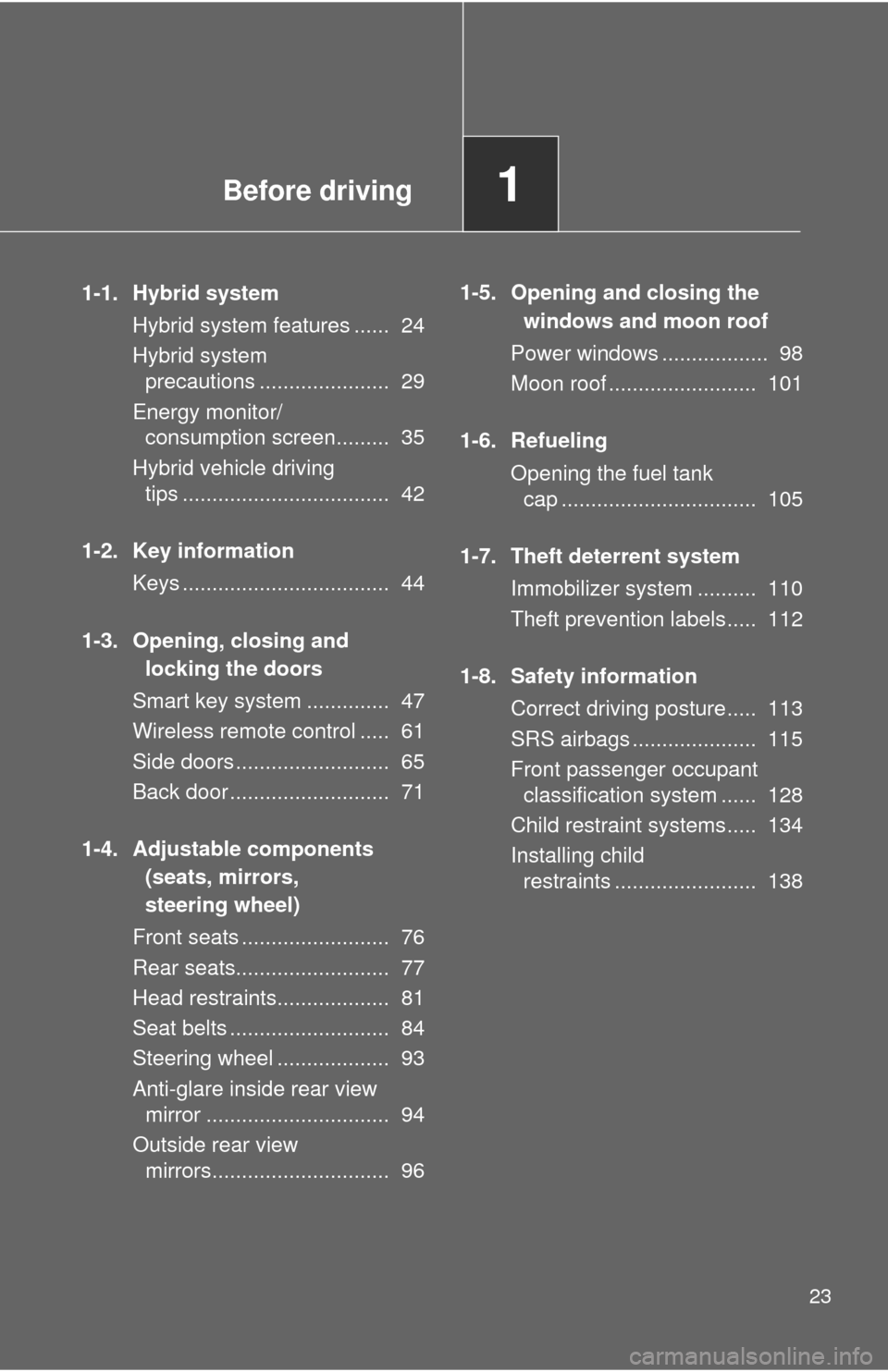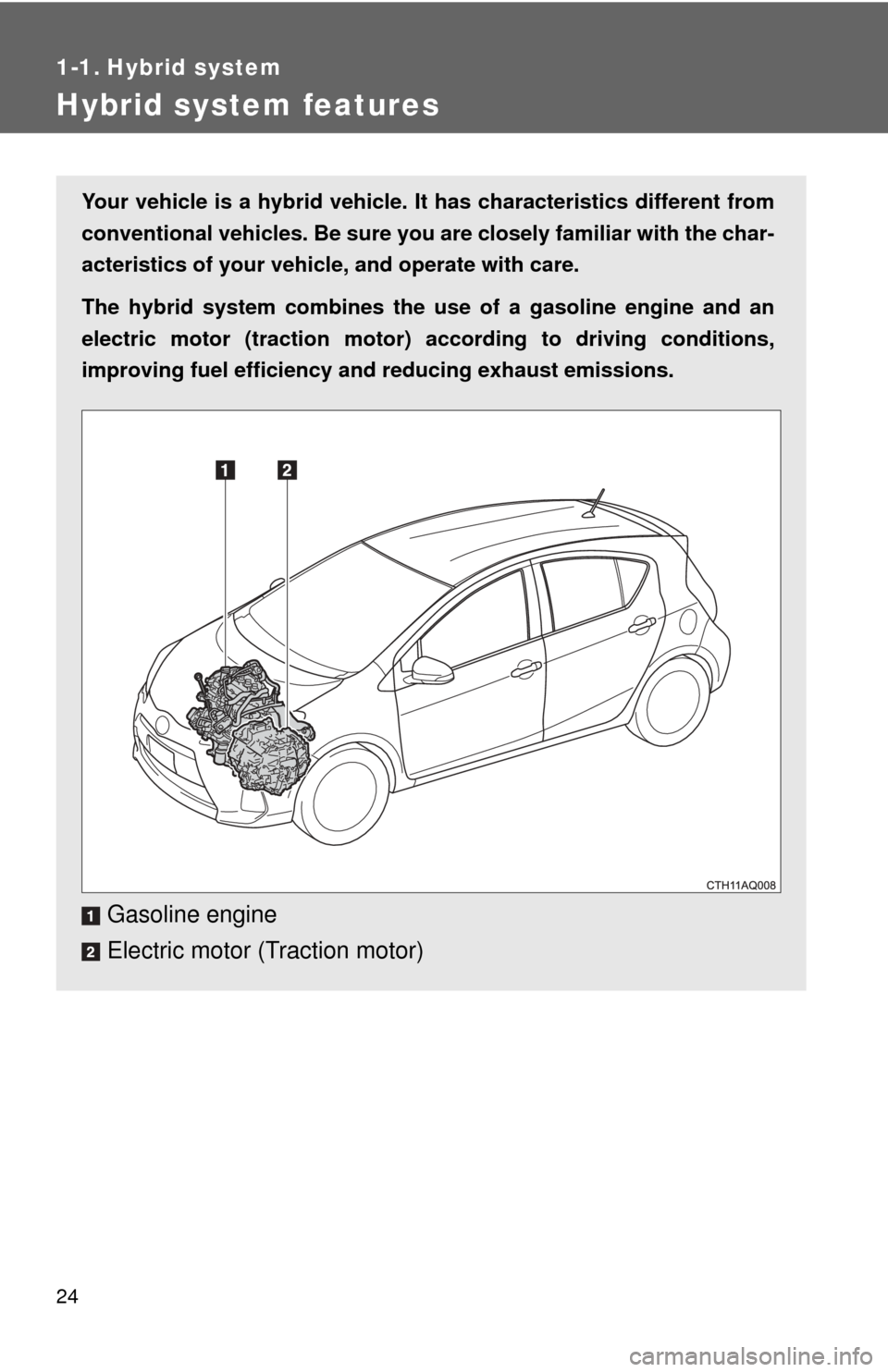2013 TOYOTA PRIUS C driving
[x] Cancel search: drivingPage 1 of 556

TABLE OF CONTENTS
1
1Before driving
Information on the hybrid system and adjusting and op-
erating features such as door locks, mirrors, and steer-
ing column.
2When drivingDriving, stopping and safe-driving information.
3Interior
featuresAir conditioning and audio systems, as well as other in-
terior features for a comfortable driving experience.
4Maintenance
and careCleaning and protecting your vehicle, performing do-it-
yourself maintenance, and maintenance information.
5When trouble
arisesWhat to do if the vehicle needs to be towed, gets a flat
tire, or is involved in an accident.
6Vehicle
specificationsDetailed vehicle information.
7For ownersReporting safety defects for U.S. owners, seat belt and
SRS airbag instructions for Canadian owners.
IndexAlphabetical listing of information contained in this
manual.
Page 2 of 556

TABLE OF CONTENTSIndex
2
1-1. Hybrid systemHybrid system features ........ 24
Hybrid system precautions ........................ 29
Energy monitor/consumption screen ................................ 35
Hybrid vehicle driving tips .... 42
1-2. Key information Keys ..................................... 44
1-3. Opening, closing and locking the doors
Smart key system................. 47
Wireless remote control ....... 61
Side doors ............................ 65
Back door ............................. 71
1-4. Adjustable components (seats, mirrors,
steering wheel)
Front seats ........................... 76
Rear seats ............................ 77
Head restraints ..................... 81
Seat belts ............................. 84
Steering wheel ..................... 93
Anti-glare inside rear view mirror .................................. 94
Outside rear view mirrors ..... 96
1-5. Opening and closing the windows and moon roof
Power windows .................... 98
Moon roof ........................... 101 1-6. Refueling
Opening the fuel tank cap .................................... 105
1-7. Theft deterrent system Immobilizer system ............. 110
Theft prevention labels ....... 112
1-8. Safety information Correct driving posture ....... 113
SRS airbags ....................... 115
Front passenger occupant classification system ......... 128
Child restraint systems ....... 134
Installing child restraints ..... 138
2-1. Driving procedures Driving the vehicle .............. 148
Engine (ignition) switch....... 158
Power (ignition) switch........ 162
EV drive mode .................... 170
Hybrid transmission ............ 173
Turn signal lever ................. 176
Parking brake ..................... 177
Horn .................................... 178
1Before driving
2When driving
Page 3 of 556

1
2
3
4
5
6
7
3
2-2. Instrument clusterGauges and meters ............ 179
Indicators and warning lights ................................. 182
Multi-information display ..... 185
2-3. Operating the lights and wipers
Headlight switch .................. 202
Fog light switch ................... 206
Windshield wipers and washer .............................. 208
Rear window wiper and washer .............................. 212
2-4. Using other driving systems
Cruise control ...................... 215
Driving assist systems ........ 219
Hill-start assist control ......... 222
2-5. Driving information Cargo and luggage ............. 224
Vehicle load limits ............... 228
Winter driving tips ............... 229
Trailer towing ...................... 233
Dinghy towing ..................... 234 3-1. Using the air conditioning
system and defogger
Automatic air conditioning system .............................. 236
Rear window and outside rear view
mirror defoggers ............... 245
3-2. Using the audio system Audio system types ............ 246
Using the radio ................... 252
Using the CD player ........... 254
Playing back MP3 and WMA discs ....................... 259
Operating an iPod .............. 266
Operating a USB memory ............................ 274
Optimal use of the audio system .............................. 282
Using the AUX port............. 285
Using the steering wheel audio switches.................. 286
3-3. Using the Bluetooth
®
audio system
Bluetooth
® audio/phone ..... 289
Using the Bluetooth®
audio/phone ..................... 293
Operating a Bluetooth
®
enabled portable player.... 298
Making a phone call ........... 301
Using the “SET UP” menu (“Bluetooth” menu) ........... 306
Using the “SET UP” menu (“Phone” menu) ................ 312
3Interior features
Page 19 of 556

19
The EDR in this vehicle is designed to record such data as:
• How various systems in your vehicle were operating;
• Whether or not the driver and passenger safety belts were buckled/fas-tened;
• How far (if at all) the driver was depressing the accelerator and/or brake
pedal; and,
• How fast the vehicle was traveling.
These data can help provide a better understanding of the circumstances in
which crashes and injuries occur.
NOTE: EDR data are recorded by your vehicle only if a non-trivial crash situ-
ation occurs; no data are recorded by the EDR under normal driving condi-
tions and no personal data (e.g., name, gender, age, and crash location) are
recorded. However, other parties, such as law enforcement, could combine
the EDR data with the type of personally identifying data routinely acquired
during a crash investigation.
To read data recorded by an EDR, special equipment is required, and access
to the vehicle or the EDR is needed. In addition to the vehicle manufacturer,
other parties, such as law enforcement, that have the special equipment, can
read the information if they have access to the vehicle or the EDR.
● Disclosure of the EDR data
Toyota will not disclose the data recorded in an EDR to a third party except
when:
• An agreement from the vehicle’s owner (or the lessee for a leased vehicle) is obtained
• In response to an official request by the police, a court of law or a govern- ment agency
• For use by Toyota in a lawsuit
However, if necessary, Toyota may:
• Use the data for research on vehicle safety performance
• Disclose the data to a third party for research purposes without disclosing information about the specific vehicle or vehicle owner
Page 20 of 556

20
Scrapping of your Toyota
The SRS airbag and seat belt pretensioner devices in your Toyota contain
explosive chemicals. If the vehicle is scrapped with the airbags and seat belt
pretensioners left as they are, this may cause an accident such as fire. Be
sure to have the systems of the SRS airbag and seat belt pretensioner
removed and disposed of by a qualified service shop or by your Toyota
dealer before you scrap your vehicle.
Perchlorate Material
Special handling may apply, See www.dtsc.ca.gov/hazardouswaste/perchlorate.
Your vehicle has components that may contain perchlorate. These compo-
nents may include airbag, seat belt pretensioners, and wireless remote con-
trol batteries.
CAUTION
■General precautions while driving
Driving under the influence: Never drive your vehicle when under the influ-
ence of alcohol or drugs that have impaired your ability to operate your vehi-
cle. Alcohol and certain drugs delay reaction time, impair judgment and
reduce coordination, which could lead to an accident that could result in
death or serious injury.
Defensive driving: Always drive defensively. Anticipate mistakes that other
drivers or pedestrians might make and be ready to avoid accidents.
Driver distraction: Always give your full attention to driving. Anything that dis-
tracts the driver, such as adjusting controls, talking on a cellular phone or
reading can result in a collision with resulting death or serious injury to you,
your occupants or others.
■ General precaution regarding children’s safety
Never leave children unattended in the vehicle, and never allow children to
have or use the key.
Children may be able to start the vehicle or shift the vehicle into neutral.
There is also a danger that children may injure themselves by playing with
the cigarette lighter, the windows, or other features of the vehicle. In addi-
tion, heat build-up or extremely cold temperatures inside the vehicle can be
fatal to children.
Page 23 of 556

Before driving1
23
1-1. Hybrid systemHybrid system features ...... 24
Hybrid system precautions ...................... 29
Energy monitor/ consumption screen......... 35
Hybrid vehicle driving tips ................................... 42
1-2. Key information Keys ................................... 44
1-3. Opening, closing and locking the doors
Smart key system .............. 47
Wireless remote control ..... 61
Side doors .......................... 65
Back door ........................... 71
1-4. Adjustable components (seats, mirrors,
steering wheel)
Front seats ......................... 76
Rear seats.......................... 77
Head restraints................... 81
Seat belts ........................... 84
Steering wheel ................... 93
Anti-glare inside rear view mirror ............................... 94
Outside rear view mirrors.............................. 96 1-5. Opening and closing the
windows and moon roof
Power windows .................. 98
Moon roof ......................... 101
1-6. Refueling Opening the fuel tank cap ................................. 105
1-7. Theft deterrent system Immobilizer system .......... 110
Theft prevention labels..... 112
1-8. Safety information Correct driving posture..... 113
SRS airbags ..................... 115
Front passenger occupant classification system ...... 128
Child restraint systems..... 134
Installing child restraints ........................ 138
Page 24 of 556

24
1-1. Hybrid system
Hybrid system features
Your vehicle is a hybrid vehicle. It has characteristics different from
conventional vehicles. Be sure you are closely familiar with the char-
acteristics of your vehicle, and operate with care.
The hybrid system combines the use of a gasoline engine and an
electric motor (traction motor) according to driving conditions,
improving fuel efficiency and reducing exhaust emissions.
Gasoline engine
Electric motor (Traction motor)
Page 25 of 556

25
1-1. Hybrid system
1
Before driving
Vehicle Proximity Notification System
When the gasoline engine is off while driving, a sound is produced to
warn pedestrians, people riding bicycles or other people and vehicles
in the surrounding area that the vehicle is approaching. The pitch of
the sound adjusts according to vehicle speed. When vehicle speed is
approximately 16 mph (25 km/h) or more, the warning system turns
off.
■ When stopped/during start off
The gasoline engine stops* when the vehicle is stopped. During
start-off, the electric motor (tra ction motor) drives the vehicle. At
slow speeds or when traveling down a gentle slope, the engine
is stopped* and the motor is used.
*: However, when the hybrid battery (traction battery) needs to be charged or while the engine is being warmed up, the gasoline
engine may not stop automatically. ( P. 26)
■During normal driving
The gasoline engine is predominantly used. The electric motor
(traction motor) charges the hybrid battery as necessary.
■ When accelerating sharply
The power of the hybrid battery (t raction battery) is added to that
of the gasoline engine via the electric motor (traction motor).
■ When braking (regenerative braking)
The electric motor (traction mo tor) charges the hybrid battery
(traction battery).